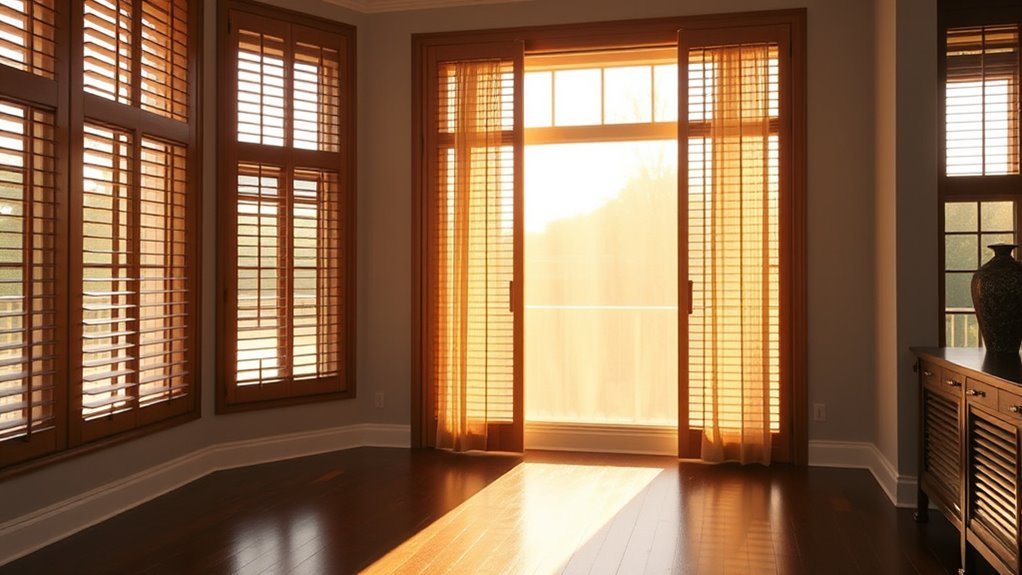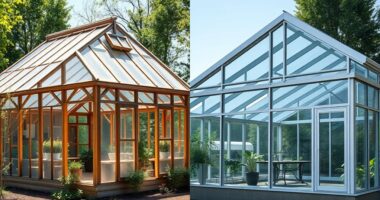Adding shades and blinds in your home helps you control light and temperature effectively. They create a comfortable ambiance while reducing energy costs by up to 77%. Various types, like cellular shades and solar shades, provide insulation and protect furnishings from UV rays. Smart shades can automate adjustments based on your schedule or temperature, enhancing convenience. If you’re curious about how to choose the right options and further optimize your space, there’s more to explore.
Key Takeaways
- Select energy-efficient shades like cellular or solar shades to enhance insulation and reduce heat gain while maintaining comfort.
- Utilize smart shades for automated adjustments based on time or temperature, optimizing energy use and enhancing convenience.
- Consider Roman and roller shades for aesthetic appeal combined with thermal linings that improve insulation and privacy.
- Regular maintenance is crucial; dust shades and inspect for wear to prolong their lifespan and efficiency.
- Integrate shades with smart home systems for customized lighting scenes and automated scheduling to manage light and temperature effectively.
The Importance of Light and Temperature Control
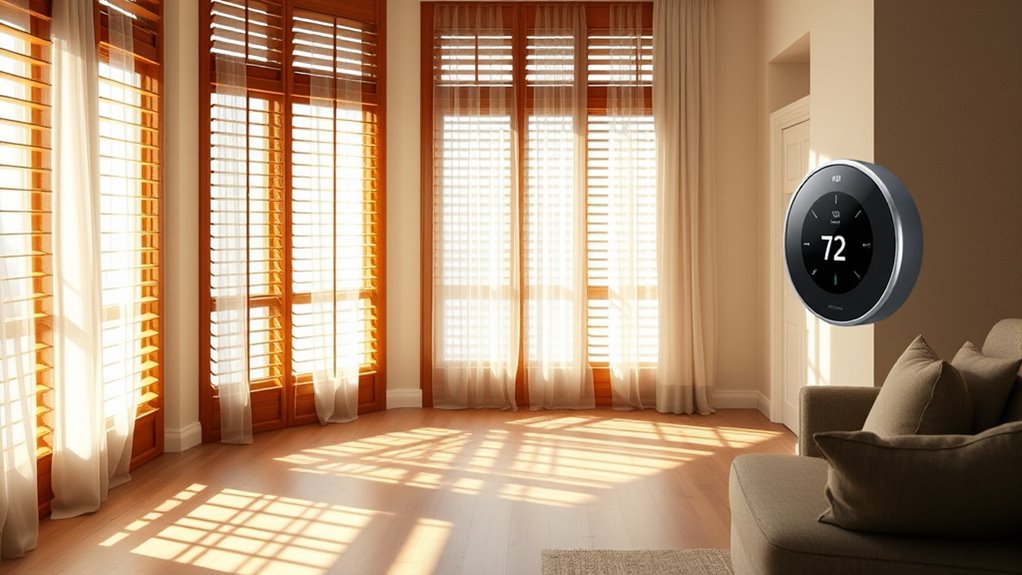
When you consider the ambiance of a space, light and temperature control play essential roles in shaping your experience.
The color temperature of your lighting can markedly affect how you feel and perform; warm tones create a cozy atmosphere perfect for relaxation, while cooler tones enhance alertness and focus, ideal for workspaces. Proper lighting doesn’t just influence mood; it also impacts cognitive performance and visual comfort.
Incorporating energy-efficient solutions, like LEDs, can help you manage these effects while reducing energy consumption. Additionally, temperature control through window treatments complements your lighting choices, keeping your space comfortable year-round.
Types of Shades for Optimal Temperature Management
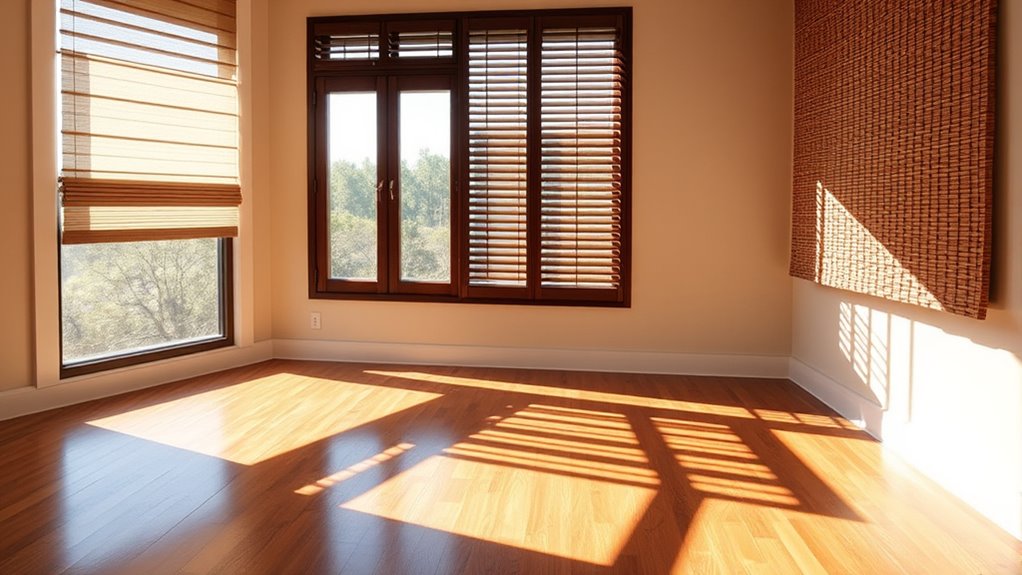
To effectively manage temperature in your home, choosing the right shades is essential. Various types of shades can help you achieve ideal temperature control while enhancing your decor.
Consider these options:
- Cellular Shades: Their honeycomb design traps air, providing excellent insulation.
- Solar Shades: These block harmful UV rays, reducing heat buildup and protecting your furniture.
- Roman Shades: With thermal linings, they offer both style and insulation.
- Roller Shades: Available in blackout and room-darkening fabrics, they effectively manage light and heat.
- Smart Shades: Program them for automated adjustments based on time or temperature.
Selecting the right shades can make a significant difference in maintaining a comfortable home environment.
Energy Efficiency Benefits of Shades and Blinds
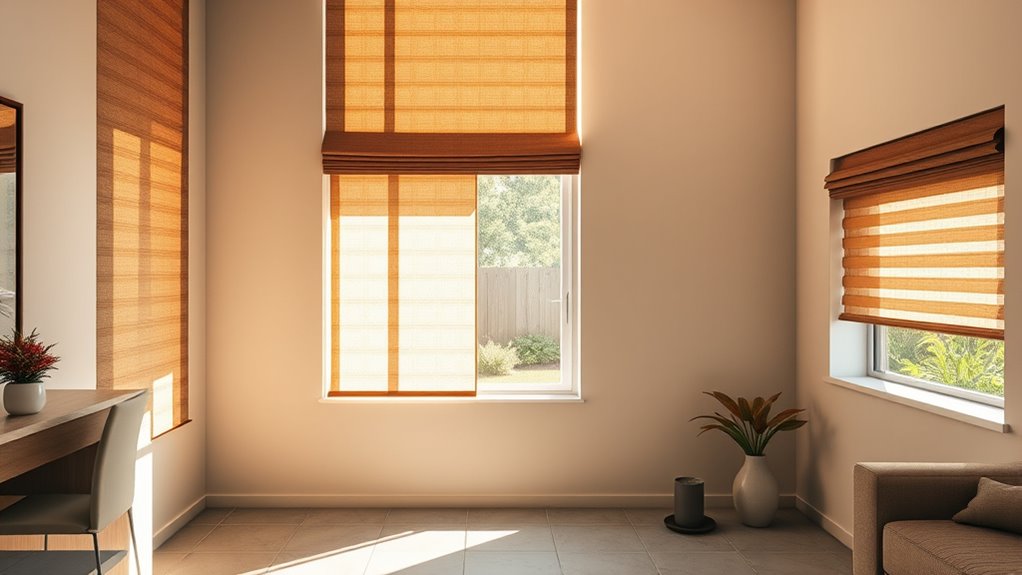
Selecting the right shades not only enhances your home’s decor but also brings significant energy efficiency benefits. By using energy-efficient blinds, you can reduce heat gain by up to 77%, leading to annual savings of up to $830. Cellular shades, in particular, provide excellent insulation, raising thermal comfort by as much as 5°F. Smart blinds can further optimize energy usage by adjusting based on light levels and temperature needs. Here’s a quick comparison of different options:
| Type of Shade | R-Value Range | Heat Gain Reduction |
|---|---|---|
| Cellular Shades | 2.0 – 5.0 | Up to 77% |
| Exterior Shades | N/A | Up to 65% |
| Plantation Shutters | 3.0 | Effective |
Investing in shades and blinds can dramatically improve your home’s energy efficiency. Moreover, maximizing renewable energy sources can further enhance the sustainability of your home’s energy use.
Exploring Light Control Options for Different Spaces
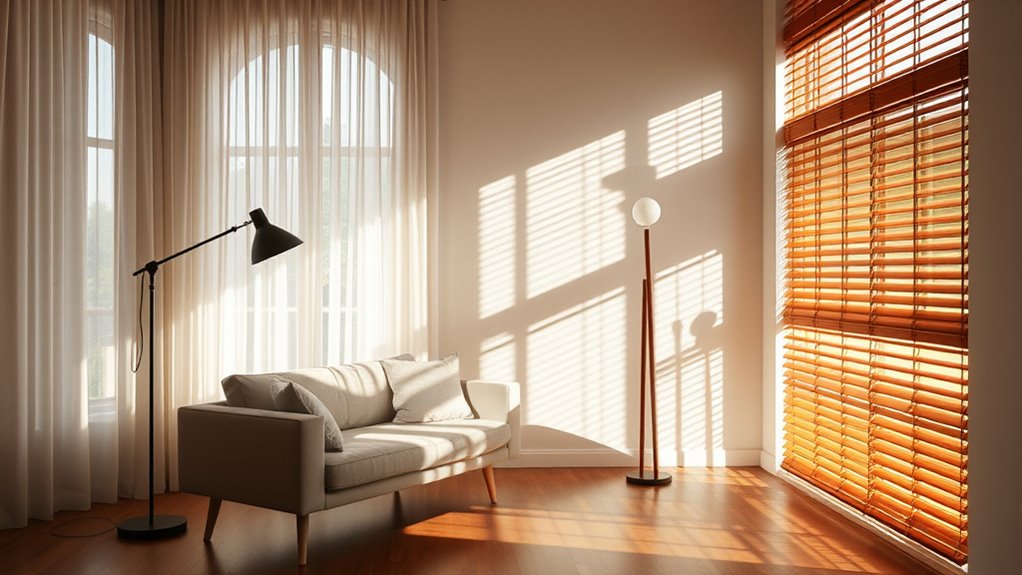
How can you effectively control light in your various living spaces?
Different environments call for tailored lighting solutions. Here are some options to contemplate for each space:
- Manual Control: Perfect for personal adjustments in residential areas.
- Occupancy Sensing: Ideal for commercial spaces, automatically managing lights.
- Time Scheduling: Great for educational facilities, ensuring lights are on when needed.
- Dimming: Use in multi-functional rooms to create the right ambiance.
- Daylight Response: Incorporate in spaces with windows to optimize natural light.
Insulation Properties of Shades and Their Impact on Comfort

When you choose shades with a honeycomb structure, you boost your home’s insulation and comfort.
These designs not only help regulate seasonal temperatures but also reduce noise, creating a more peaceful environment.
You’ll notice the difference in both your comfort and energy bills.
Honeycomb Structure Insulation
Honeycomb structure insulation offers an innovative solution for enhancing comfort in your home.
These unique designs feature interconnected hexagonal cells that trap air, providing exceptional thermal and acoustic insulation.
By opting for honeycomb blinds, you can enjoy significant benefits:
- Reduces heat loss by up to 40%, improving energy efficiency.
- Outperforms traditional thermal curtains, which only cut heat loss by 25-30%.
- Provides both light filtering and blackout options for privacy.
- Versatile materials like aluminum and sustainable options contribute to eco-friendliness.
- Maintains structural stability, enhancing sound insulation.
With honeycomb blinds, you’re not just investing in aesthetics but also in comfort and energy savings throughout the year.
Seasonal Temperature Regulation
As seasons change, adjusting your window shades and blinds becomes essential for maintaining a comfortable indoor climate.
In winter, keeping your curtains closed at night traps warmth while opening them on sunny days invites natural heat. Tilt blinds to direct sunlight inward without sacrificing privacy.
In summer, close blinds to deflect sunlight and reduce heat gain by up to 45% with highly reflective materials. Cellular shades can cut unwanted solar heat by 80%, enhancing cooling efficiency and easing the load on your air conditioning.
Noise Reduction Benefits
Adapting your window treatments not only helps with temperature control but also plays a significant role in reducing noise levels in your home.
Shades with insulating properties can create a tranquil environment, keeping unwanted sounds at bay. Here are some key benefits of noise-reducing shades:
- Cellular shades trap sound effectively with honeycomb cells.
- Layering treatments like drapes enhance sound absorption.
- Thicker materials provide better noise insulation.
- Duette Honeycomb Shades absorb up to 70% of sound energy.
- Blackout shades offer added sound dampening with their density. Additionally, the emotional stability provided by a serene environment can help individuals cope with challenges related to emotional instability.
Noise Reduction Benefits of Cellular Shades
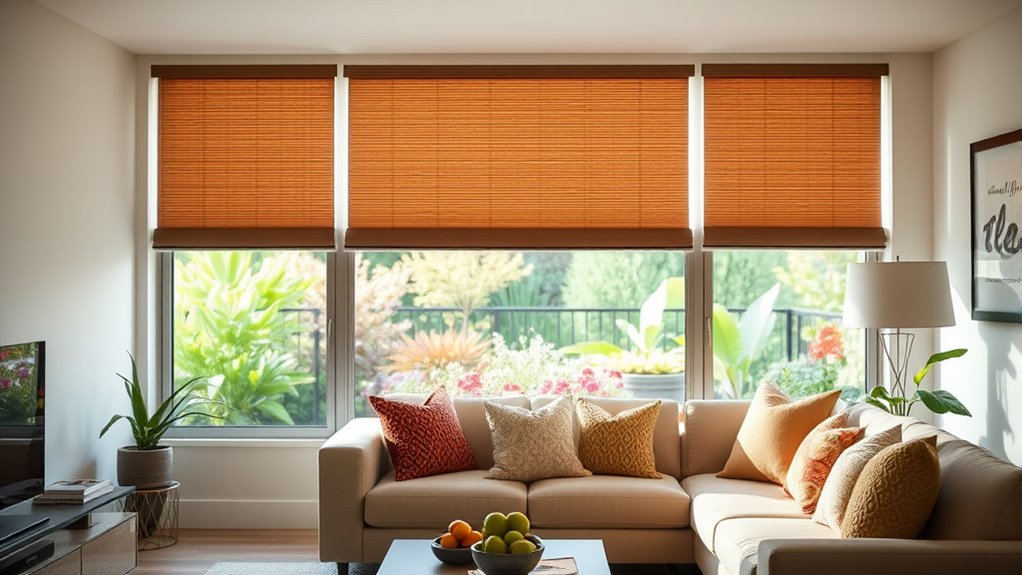
If you’re looking to enhance the tranquility of your home, consider the noise reduction benefits of cellular shades. Their unique honeycomb structure traps air and sound, cutting noise transfer by over 50%.
This design absorbs sound effectively, making it ideal for creating a peaceful environment. If you need even more noise reduction, double cell shades offer superior insulation compared to single cell options.
With reduced noise levels, you’ll enjoy improved sleep quality and enhanced focus in your home office or study. Plus, they provide excellent privacy, making them perfect for bedrooms.
Cellular shades come in various styles and colors, allowing you to customize your space while enjoying these significant noise reduction advantages.
Installation Tips for Effective Shade Placement
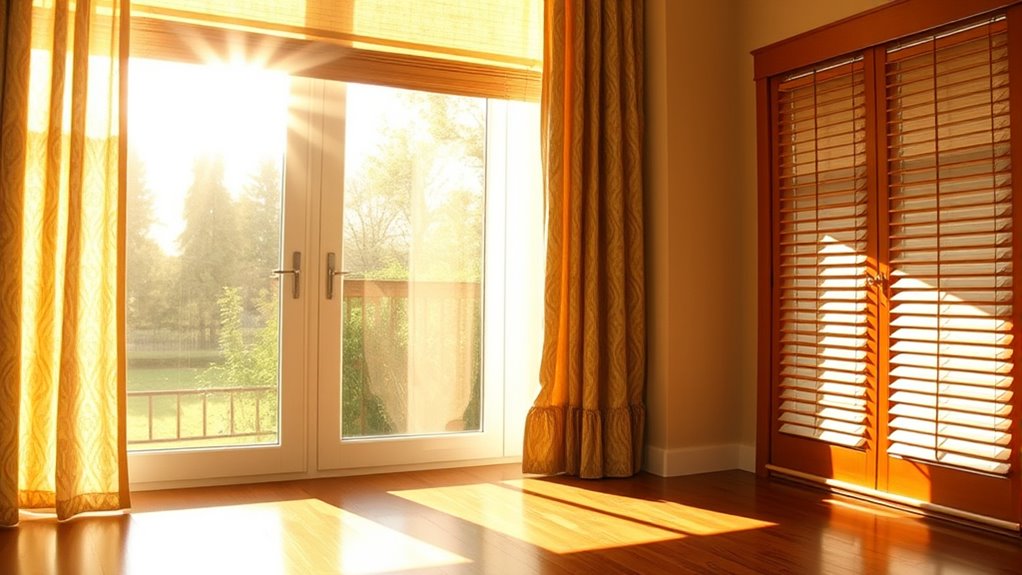
When you’re ready to install shades, proper preparation is key to guaranteeing effective placement. Start by gathering your tools and materials, then measure your windows accurately to decide between inside or outside mounts.
Make sure to prioritize safety precautions, especially when using a ladder.
Prioritize safety when installing shades, especially when using a ladder for access.
Here are some tips for effective shade placement:
- Measure at the top, middle, and bottom of the window frame for accuracy.
- Mark bracket locations with a pencil for precise installation.
- Drill pilot holes to prevent wood splitting.
- Use a level to guarantee brackets are straight.
- Follow the manufacturer’s instructions for specific installation details.
Maintenance and Cleaning Considerations
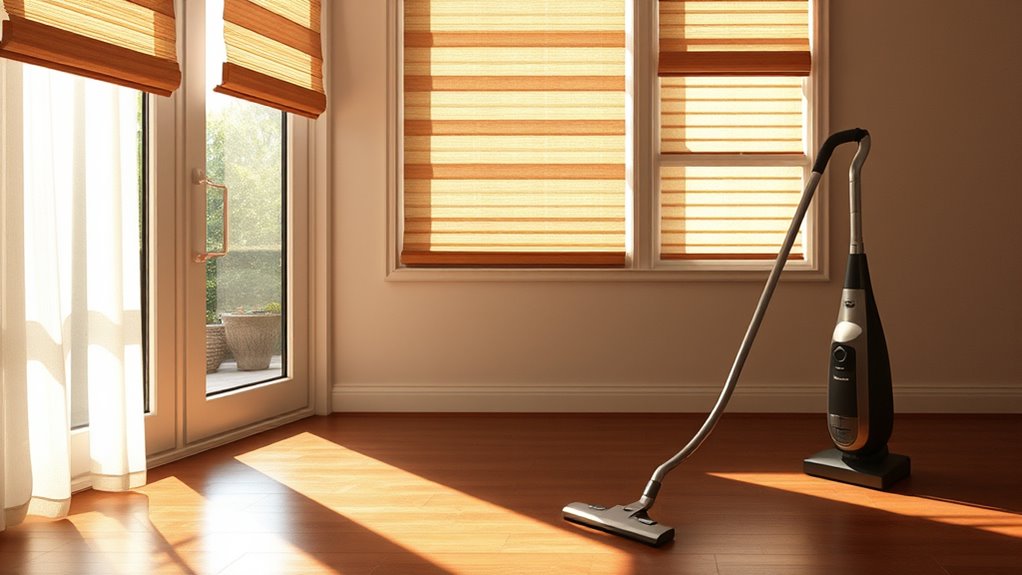
To keep your shades looking their best and functioning properly, regular maintenance and cleaning are essential. Periodically inspect for wear and tear, tightening any loose components like cords and brackets.
Dust your shades using a soft brush attachment or a duster to avoid buildup. For cleaning, use material-specific methods: spot clean fabric shades with a mild detergent, wipe vinyl shades with a damp cloth, and gently dust wooden shades with a soft, damp cloth.
Avoid harsh chemicals and never immerse delicate shades in water. Before storing, clean them thoroughly and follow manufacturer’s guidelines for proper folding.
Store in a cool, dry place, away from direct sunlight to prevent damage. Regular attention will prolong their life and maintain their appearance.
Smart Home Integration for Enhanced Control
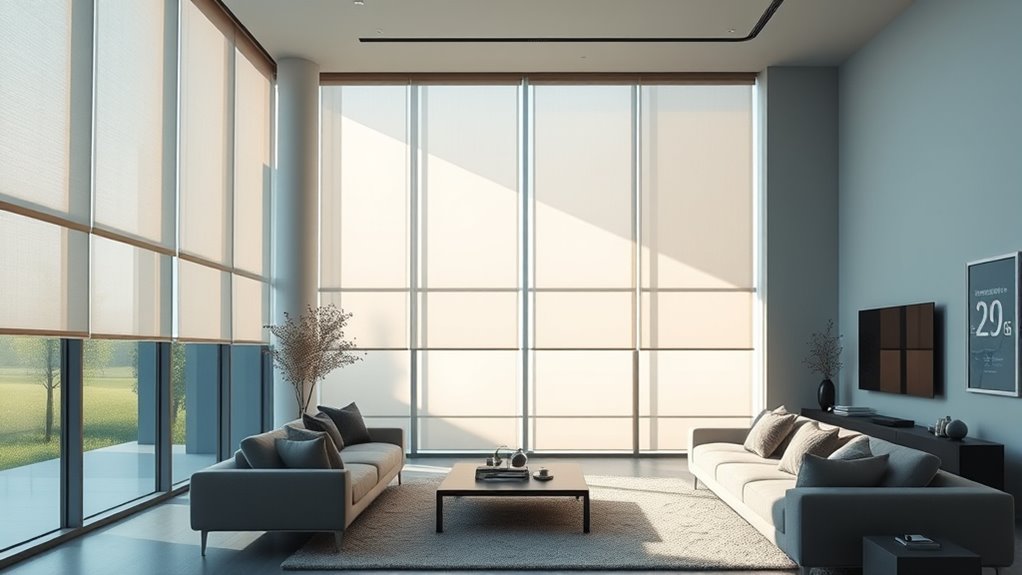
Integrating smart shades into your home not only enhances convenience but also allows you to automate scheduling for ideal light and temperature control.
With thermostat compatibility, you can guarantee your home remains energy-efficient while enjoying your customized lighting scenes. Regular maintenance of your heat pump system can further enhance energy efficiency and ensure optimal performance. Additionally, choosing energy-efficient heat pumps can significantly lower carbon emissions while optimizing your home’s climate control and reducing energy bills. Furthermore, utilizing advanced filtration systems in your heat pump can improve indoor air quality, contributing to a healthier living environment. Incorporating smart technology into your heating and cooling systems can lead to even greater energy savings and comfort.
This seamless integration brings a new level of comfort and efficiency to your living space.
Automated Scheduling Benefits
Automated scheduling offers a seamless way to enhance your home’s light and temperature control, ensuring maximum comfort and efficiency.
By programming your shades to adjust based on specific times or weather conditions, you can enjoy a host of benefits:
- Energy Efficiency: Optimize shade operation to reduce energy consumption.
- Cost Savings: Lower your utility bills by minimizing unnecessary heating and cooling.
- Convenience: Manage light and temperature effortlessly without manual adjustments.
- Customization: Set schedules that cater to your lifestyle and preferences.
- Integration: Connect with other smart home devices for unified control.
With automated scheduling, you’ll create a more comfortable living environment while enjoying the added convenience of smart technology.
Thermostat Compatibility Features
While managing your home’s climate, understanding thermostat compatibility features can greatly enhance your smart home experience.
Smart thermostats seamlessly integrate with various devices, including shades and blinds, giving you enhanced control over your environment. With voice assistant support, you can easily adjust settings using simple commands.
Remote access through smartphone apps means you can change the temperature even when you’re away. These thermostats also learn your preferences, making automatic adjustments that optimize comfort and energy efficiency.
Plus, they track your energy usage, providing valuable insights to help you make informed decisions. By harmonizing temperature and light control, you create a comfortable and efficient living space tailored to your needs.
Customized Lighting Scenes
Customized lighting scenes transform the way you experience your home, allowing you to create the perfect ambiance for any occasion.
With smart home integration, you can control your lighting effortlessly through apps or voice commands.
Here are some benefits of customized lighting scenes:
- Enhanced Ambiance: Boost your mood with tailored lighting.
- Energy Efficiency: Optimize light usage based on occupancy.
- Security Features: Simulate occupancy when you’re away.
- Versatility: Switch between scenes for different activities.
- Personalization: Set unique moods for moments like “Movie Night.”
Choosing the Right Shades for Your Home

How do you choose the right shades for your home? Start by considering the type of shades that fit your windows. Roller shades work well for narrow spaces, while Roman shades suit any width.
If insulation and privacy are priorities, opt for cellular shades. For a natural vibe, try bamboo or woven wood shades.
Next, think about materials and fabrics. Light-filtering options provide gentle illumination, while blackout shades offer complete darkness.
Choose colors that complement your decor—neutral tones are versatile, but bold colors can make a statement.
Finally, assess your light control needs and installation preferences. Custom shades can fit unique windows, and don’t forget about maintenance; some fabrics require more care than others.
Frequently Asked Questions
What Are the Best Shades for Bedrooms?
When choosing the best shades for your bedroom, consider styles like Roman, roller, or cellular shades.
Roman shades add classic elegance, while roller shades offer a minimalist look.
If energy efficiency is a priority, cellular shades are great for temperature regulation.
For complete darkness, blackout shades are perfect for light-sensitive sleepers.
Think about your decor and needs, as you can find shades that fit any style and provide the privacy you desire.
How Do I Measure Windows for Shades?
Measuring your windows is like setting the stage for a beautiful play. Grab a steel tape measure, paper, and pencil.
You’ll want to measure the width at the top, middle, and bottom, then choose the smallest. For height, measure left, middle, and right, taking the largest.
Always jot down those numbers right away! If you need extra help, don’t hesitate to call in a professional. Accuracy is your best friend here!
Can Shades Reduce Glare on Screens?
Yes, shades can effectively reduce glare on screens. By softening natural light, they minimize reflections that interfere with visibility.
Solar screen shades and sheer fabric options are particularly good at maintaining your view while cutting down on harsh light.
You’ll find that using the right shades not only enhances your screen experience but also protects your eyes and reduces strain.
What Colors Are Best for Energy Efficiency?
Imagine you live in a sunny area and decide to paint your house a light beige. This choice reflects sunlight effectively, keeping your home cooler without cranking up the air conditioning.
For energy efficiency, you’ll want to contemplate white or light neutral colors, as they can reflect up to 80% of sunlight.
Alternatively, if you’re in a colder region, light grays can help balance warmth and reflection, optimizing comfort year-round.
How Long Do Shades Typically Last?
Shades typically last between 5 to 7 years, depending on the type and quality.
Cellular and Roman shades usually fall within this range, while cordless shades can last a bit longer.
Factors like material quality, maintenance, and environmental conditions play a significant role in their lifespan.
Regular cleaning and careful handling can help extend their use, so staying proactive will guarantee you get the most out of your investment in window treatments.
Conclusion
In the grand theater of your home, shades and blinds are the curtains that control the spotlight. By mastering light and temperature, you create a comfortable scene where every moment feels just right. Think of them as your stagehands, working silently to enhance your living experience, while also saving energy. So, as you choose your perfect shades, remember—you’re not just dressing your windows; you’re crafting an inviting atmosphere where comfort takes center stage.
